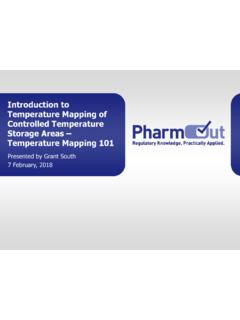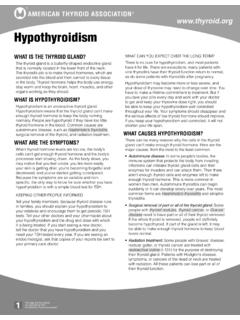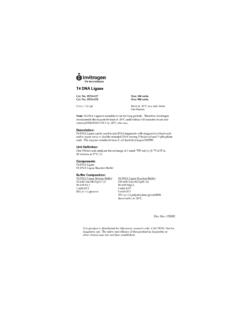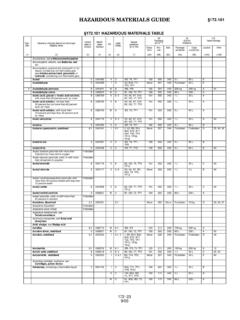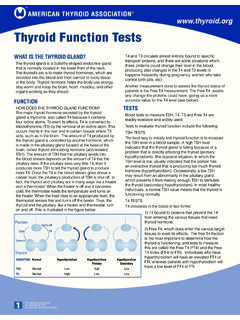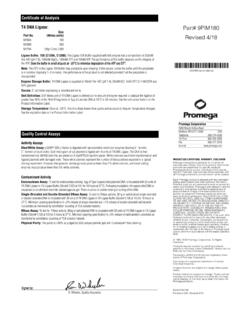Transcription of EMA and FDA Approaches to Process Validation
1 EMA and FDA Approaches to Process ValidationPresented by Ashley Isbel and Marc Fini4 July, 2016 Slide 2 PharmOut 2015 Agenda Where do the EMA and FDA disagree? Where do they ask for different requirements? How you can develop a single approach to be compliant across both regulatorsWhat are the key differences between the EMA and FDA Approaches for Process Validation ?How you can navigate the two Approaches to present an integrated, compliant strategy. What are the main changes from the previous Approaches ? Are you going to require significant change and investment to comply?A quick overview of the new FDA and EMA Process Validation approachesPart 1: Overview of the New Process Validation RequirementsSlide 4 PharmOut 2015 FDA Approach to Process ValidationEmphasised in the FDA s 2011 guidance document Process Validation : General Principles and Validation is the collection and evaluation of data, from the Process design stage through commercial production which establishes scientific evidence that a Process is capable of consistently delivering quality product.
2 Slide 5 PharmOut 2015 FDA Approach to Process ValidationObjectiveTo understand and control input variabilityimpact and manufacturing Process to assure consistent product quality and reliable supply. Science and Risk based PV / PPQ product and Process understanding, good science, statistical confidence. Statistically based sampling plans and acceptance criteria for PPQ / PV and release. Understanding the impact of variability and demonstrating control strategy is robust beyond the variability Variability in raw materials / excipients, parameter control, operators, shifts, equipment sets, 6 PharmOut 2015 FDA Process Validation LifecycleSlide 7 PharmOut 2015 FDA Approach to Process ValidationPV Stage 3a (Establishing initial Process variability) We recommend continued monitoring and sampling of Process parameters and quality attributes at the level established during the Process qualification stage until sufficient data are available to generate significant variability estimates.
3 PV Stage 3b (After variability established) Monitoring can then be adjusted to a statistically appropriate and representative level. Slide 8 PharmOut 2015 EMA Approach to Process Validation A quality risk management approach should be applied throughout the lifecycle of a medicinal product. As part of a quality risk management system, decisions on the scope and extent of qualification and Validation should be based on a justified and documented risk assessment of the facilities, equipment, utilities and processes. A robust product development Process is required to enable successful Process Validation . Before product is released to the market, the Process must be shown to be robust and ensure consistent product quality irrespective of the approach 9 PharmOut 2015 EMA Approach to Process Validation Retrospective Validation no longer acceptable. Concurrent Validation only acceptable where there is a strong benefit-risk ration for the patient.
4 Appropriate quality oversight over the whole Validation life cycle is 10 PharmOut 2015 EMA Approach to Process Validation The V-model concept is still appropriate. Testing completed during FAT / SAT can be leveraged provided that: The strategy is defined up front. Good documentation practice and data integrity practices are followed throughout the testing. Appropriate quality oversight is applied to the 2: Key differences between the EMA and FDA Approaches for Process validationSlide 12 PharmOut 2015 EMA vs. FDA Differences The differences in the guidance documents are not significant. Properly developed processes / products should meet the expectations of both EMA & FDA. The core expectations of both EMA & FDA with respect to Process Validation overall are nearly identical and likely to be more closely aligned in the future. FDA Currently effective EMA Final version released 30thMarch 2015 Effective 1stOctober 2015 Slide 13 PharmOut 2015 EMA vs.
5 FDA The Focus FDA focuses on understanding and controlling variability. EMA focuses on science based, quality risk management. EMA tends to be more apprehensive with respect to novelty and identifies specific products / processes where additional products / processes where additional concerns are present. There is substantially less mention in the EMA guidance with respect to the use of 14 PharmOut 2015 EMA vs. FDA Process Validation Life Cycle FDA uses the term Process Validation to refer to the life cycle of Validation , from Process design to routine manufacture. EMA uses the term Process Validation to represent the life cycle of the product. Qualification and Validation is used to define processes applicable to facilities, services and DesignProcess QualificationContinuedProcess VerificationContinuous ImprovementSlide 15 PharmOut 2015 EMA vs. FDA Number of PV / PPQ batches EMA it is generally considered acceptable that a minimum of three consecutive batches manufactured under routine conditions could constitute a Validation of the Process .
6 FDA Each manufacturer should judge whether it has gained sufficient understanding to provide a high degree of assurancein its manufacturing Process to justify commercial distribution of the product Slide 16 PharmOut 2015 Continued vs Continuous vs Ongoing Process VerificationContinuous Process Verification. An alternative approach to Process Validation in which manufacturing Process performance is continuously monitored and Process Verification (aka continued Process verification). Documented evidence that the Process remains in a state of control during commercial Process Verification. Continual assurance that the Process remains in a state of control (the validated state) during commercial 17 PharmOut 2015 Continued vs Continuous vs Ongoing Process Verification Continuous Process Verification is usually done by some form of Process Analytical Technology (PAT). FDA requires that data from Continuous Process Verification is assessed after every batch.
7 EMA states that there should be a regular evaluation of the control strategy .Part 3: Navigating the two Approaches to present an integrated, compliant strategySlide 19 PharmOut 2015A paradigm shiftA new direction towards a: Science-Based Risk-Based Cost Effective approach to ensuring patient safety & product quality during pharmaceutical development and manufacturingSlide 20 PharmOut 2015 International Conference on Harmonization (ICH)In Brussels, 2008 the International Conference on Harmonization established the following goal: Develop a harmonised pharmaceutical quality systemapplicable across the lifecycleof the product emphasizing an integrated approach to quality risk managementand science. Slide 21 PharmOut 2015 ICH Q8 Pharmaceutical DevelopmentQuality by Design (QbD): A systematic approach to development that begins with predefined objectives and emphasizes product and Process understanding and Process control, based on sound science and quality risk management.
8 Slide 22 PharmOut 2015 ICH Q9 Quality Risk Management The level of effort, formality and documentation of the QRM Process should be commensurate with the level of risk. Slide 23 PharmOut 2015 ICH Q11 Development & Manufacture of Drug Substances A company can choose to follow different Approaches in developing a drug substance. For the purpose of this guideline, the terms traditional and enhanced are used to differentiate two possible Approaches . Traditional approach:Set points and operating ranges for Process parameters are defined and the drug substance control strategy is typically based on demonstration of Process reproducibility and testing to meet established acceptance 24 PharmOut 2015 ICH Q11 Development & Manufacture of Drug SubstancesEnhanced approach: Risk management and scientific knowledge are used more extensively to identify and understand Process parameters and unit operations that impact critical quality attributes (CQAs) and develop appropriate control strategies applicable over the lifecycle of the drug substance which mayinclude the establishment of design space(s).
9 Slide 25 PharmOut 2015 FDA (& EU) Process Validation StagesStage 1 Process Design: The Process is defined during this stage based on knowledge gained through development and scale-up activities. Stage 2 Process Qualification: During this stage, the Process design is evaluated to determine if the Process is capable of reproducible commercial manufacturing. Stage 3 Continued Process Verification: Ongoing assurance is gained during routine production that the Process remains in a state of sources of VariabilityControl of VariabilityMonitoring Variability-remains in control Slide 26 PharmOut 2015 Stage 1 Process Design: The Process is defined during this stage based on knowledge gained through development and scale-up activities. Identify sources of VariabilitySlide 27 PharmOut 2015 Quality Risk Management (QRM)The QRM Process must be systematic with defined policies and proceduresMust operate across the lifecyclePrinciples and methodologies should be clearCriteria and decisions from assessments should be documentedSlide 28 PharmOut 2015 Product realisation by QbDDefine the Quality Target Product Profile (QTPP)Identify the CQAsDefine Process Steps & CPPsCreate a Control StrategyStage 1 Implement the Control StrategyQualify Facility, Systems and EquipmentProcess Validation (PV or PPQ)ContinuedProcess VerificationStage 2 Stage 3 Science and Risk-based Approach at all Stages of LifecycleSlide 29 PharmOut 2015 Stage 1- Process & Product Knowledge Process & Product Knowledge gathered to develop a Control Strategy.
10 Robust Process with low variability. Effort focussed using Risk Assessment. Efficient Planning ensures success through the entire the Quality Target Product Profile (QTPP)Slide 30 PharmOut 2015 Stage 1- Process & Product KnowledgeProduct & Process Knowledge can come from a variety of sources: Previous experience with the Process or a similar Process . Analytical and product data from clinical studies. Process Development information. Small scale or engineering studies/batches. Clinical manufacturing. Technology TransferDefine the Quality Target Product Profile (QTPP)Slide 31 PharmOut 2015 Quality Target Product Profile (QTPP) A prospective summary of the quality characteristicsof a drug product that ideally will be achieved to ensurethe desired quality, taking into account safetyand efficacyof the drug product .(ICH Q8)Define the Quality Target Product Profile (QTPP)Slide 32 PharmOut 2015 Quality Target Product Profile (QTPP)Pharmaceutical Development goals are to design a quality pre-defined objectives and document the summary as a QTPP: Summarise the quality attributes that ensures safety and efficacy.
